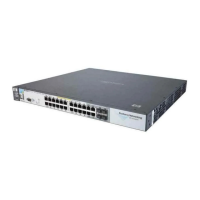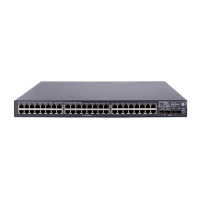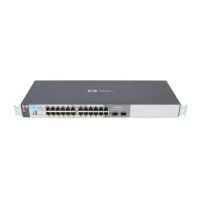Appendix E: LLDP-MED
IEEE 802.1AB Link Layer Discovery Protocol (LLDP) provides a standards-based method that enables devices
such as HP ProCurve switches to advertise themselves to adjacent devices and to learn about adjacent LLDP
devices. An LLDP packet transmitted by an HP ProCurve switch contains data about the switch and port.
The switch advertises itself to adjacent (neighbor) devices by transmitting LLDP data packets out all ports on
which outbound LLDP is enabled, and reading LLDP advertisements from neighbor devices on ports that are
inbound LLDP-enabled. An LLDP-enabled port receiving LLDP packets inbound from neighbor devices stores
the packet data in a neighbor database (MIB).
LLDP provides the base capabilities for network devices, but was not considered sufficient for IP telephony
devices. As a result, in 2004, an initiative by Mitel, HP ProCurve, Avaya, and Enterasys was undertaken to
enhance LLDP so that it could better support IP telephony devices. The development of LLDP-Medium Endpoint
Discovery (LLDP-MED) (ANSI/TIA-1057/D6) extended the LLDP standard to support advanced features on
the network edge for VoIP endpoint devices with specialized capabilities and LLDP-MED standards-based
functionality. The extensions to LLDP include the specification of additional TLV (type, length, and value)
entries specifically for VoIP management.
LLDP-MED benefits include:
•Plug-and-playprovisioningforMED-capable,VoIPendpointdevices
•Simplified,vendor-independentmanagement,enablingdifferentIPtelephonysystemstointeroperateonone
network
•AutomaticdeploymentofconvergencenetworkpoliciesthatincludevoiceVLANs,Layer2/CoSpriority,
and Layer 3/QoS priority
•ConfigurableendpointlocationdatatosupporttheEmergencyCallService(ECS)suchasEnhanced911,
999, and 112
•DetailedVoIPendpointdatainventoryreadableviaSNMPfromtheswitch
•PoweroverEthernet(PoE)statusandtroubleshootingsupportviaSNMP
•SupportforIPtelephonynetworktroubleshootingofcallqualityissuesviaSNMP
Figure A5.
64

